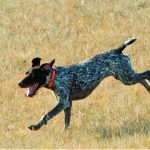Giardiasis
by Dr. Dave Erlewein
When we take to the fields and woodlands with our canine hunting buddies, a discussion of one of the more common “nuisance”-type infections our dogs might acquire seems to come up. I’m thinking about Giardiasis, an intestinal infection caused by the microscopic one-celled organism Giardia canis. These nasty little bugs are found in streams, ponds, lakes, and wells contaminated with animal or human feces. On occasion, flooding and/or breakdown of sewer systems results in the contamination of municipal water supplies. Giardia is found throughout the United States and indeed, most of the world. While the infection can spread from animals to humans, most people acquire the infection the same way as their pets, consumption of contaminated water.
There is still much we do not know about Giardia. For example, we don’t know how many different species of the organism exist, nor do we know which species infects which animals. Most experts feel that while infection is common, clinical disease from the infection is rare.
Infection begins when a dog swallows a cyst form of the parasite. In the small intestine, the cyst shell is digested away, releasing two active forms of the bug, called trophozoites. The trophozoite has a single whip-like appendage called a flagella, which it uses to move around in the intestine from one spot to another. Trophozoites multiply by dividing in two.
While we do not know how many times a trophozoite divides, at some point the trophozoite develops a wall around itself forming a cyst. This form passes in the feces. The cyst form can remain infective for many months if it remains cool and wet. Each cyst contains two trophozoites ready to infect the next host. It takes 5-12 days after infection before Giardia will be present in the host’s feces.
While most experts believe that the majority of infections do not cause illness some will produce diarrhea. Diarrhea ranges from mild to severe diarrhea and younger animals are most commonly and most severely affected. Diarrhea can be intermittent or chronic and often the stools contain a large amount of mucous or appear frothy. The diarrhea is usually not bloody and may actually clear on its own. Some cases, however, become chronic resulting in weight loss and a generally unthrifty appearance. Though the exact mechanism for production of diarrhea is unknown, the organism can damage the lining of the intestine and interfere with digestion and absorption of nutrients.
Until recently, Giardia infections were diagnosed by identifying the organisms in fecal material with a microscope. Direct identification of Giardia is often difficult as the organism is very small and easily confused with pollens, yeasts, and other artifacts found in the stool and shedding of the organism is often intermittant. It may be necessary to test the stools daily for 3-5 days. The development of a commercial test for identifying Giardia has dramatically improved the ease and accuracy in identifying the organism. The test is relatively inexpensive and only takes a few minutes. Fresh stool is necessary, and it may be necessary to re-test.
Fenbendazole is the most commonly used and most effective drug to treat Giardiasis. Clipping the fur around the anus, under the tail, and the posterior aspect of the rear legs followed by bathing is an effect aid in treatment. Other drugs used in treatment include metronidazole and albendazole.
Bleach diluted 1:32 is one of the most effective disinfectants used to treat the environment. Organic materials such as leaves, mulch, dirt, etc are protective for the cysts necessitating thorough removal of all such material from kennels, runs and pens before disinfecting with the bleach solution. Drying and direct sunlight are the only means to eliminate the organism from lawns and gardens.
A Giardia vaccine is produced by Fort Dodge Animal Health and is readily available, although its use is somewhat controversial. The vaccine label indicates it is, “an aid in the prevention of disease and shedding caused by Giardia lamblia infections.” As stated, the vaccine does not prevent infection but may reduce illness and/or shedding. The 2006 Guidelines of the American Animal Hospital Association list this vaccine as “Not Recommended.” The best use of the vaccine would be in kennels to reduce the spread of the disease.
We do know that humans can become infected with Giardia, but we do not know for sure if canine giardia are capable of infecting people. Until we answer this question, the prudent course would be to consider infected dogs capable of spreading the infection to people.
Giardia infection is rarely, if ever, life-threatening, but it can be a real nuisance and a threat to other dogs and possibly the human members of their pack.



